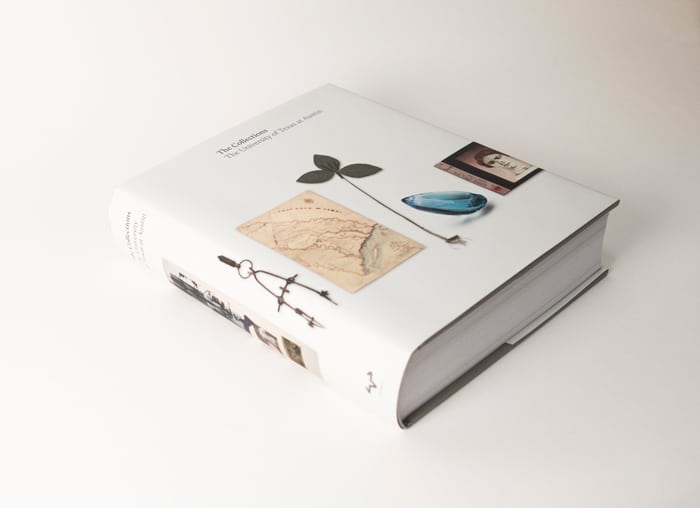
Over 700 pages of fascinating information in “The Collections”
Credit: The University of Texas at Austin
The huge educational institution that sits in the middle of our city, The University of Texas at Austin, contains millions of objects that reflect human history. In January 2016, The University of Texas Press published a book called “The Collections,” which details some of the items on campus that exemplify history and culture across more than 700 pages.
As Austinites, we either feel a kinship with The University of Texas campus or we feel detached from it. By learning about UT’s collections, this institution can become more accessible to us and deepen our appreciation for the university.
What Are “The Collections”?
https://www.instagram.com/p/BA2Y4fupXpv/
The University of Texas was founded in 1881 with eight professors leading classes for 221 students. The first significant items the university obtained were 1,200 books for the library. Later, they acquired ancient coins and the collection of historical objects began.
Surprisingly, even after 135 years of collecting, there was no central database containing information on all of these items. This is actually common for large universities, since they primarily aim to educate rather than serve as a museum, and each department is focused on its own research.
Traditionally, only parts of the UT universe have made their collections accessible, like the Blanton Museum, Ransom Center, LBJ Library and Briscoe Center. But when all of the university’s 40 administrative units are combined, the UT collection includes over 170 million objects, outnumbering the Smithsonian’s 130 million items.
Taking on a Massive Project
https://www.instagram.com/p/BCjDog6JXuJ/
Who would take on the incredibly ambitious project of diving into millions of items? The task was self-appointed by Andrée Bober, current director of Landmarks, UT’s public art program. In 2004, Bober began hunting through the collections spread all over campus.
“It was so elusive finding this stuff,” Bober told me during an interview. “There were situations where a facility member wouldn’t know there were objects centrally related to their discipline in another unit on campus.” Many of these objects were brought to light so other departments could use them, and were even photographed professionally for the first time.
By going through the steps of discovering these items, Bober was able to see all of the elements come together: the people who made or used the object, the people who brought the item to UT and the people who valued the item. “I could argue that every object in the book, I had some connection to,” Bober said. But she still had to whittle down the 7,000 images shot while working on the project to only 1,000 items to highlight in the book.
Organizing the Objects
https://www.instagram.com/p/-b-Y8flH1e/
While organizing the featured items for “The Collections,” Bober made a point to “not make distinctions between fine art and scientific specimen.” She also made sure that “the inherent value of the object was greater than the information content that it conveyed.” This means that archives or library books were not included unless they were extremely rare.
Most of the items in the book are divided by administrative unit as opposed to their type of material because, “The units really wanted to represent their holdings within the umbrella of their study,” Bober explained. “If you only read about the Briscoe Center [for American History’s] maps in one pocket, and then you read about their rare books in another pocket, you get a sense of the materiality, but you don’t get a sense of how they’re related to the history of the United States.”
The book also holds three chapters to address the crossover of cartography, textiles, and rocks and minerals. This way, “The Collections” can hone in on how important these items are across disciplines.
Specific Specimens to Note
https://www.instagram.com/p/BE9aQ64qyXh/
When flipping through “The Collections,” readers can spot Austin-centric items like Willie Nelson and Stevie Ray Vaughn posters in the Texas Poster Art Collection at the Briscoe Center, and even a preserved Barton Springs Salamander in the Texas Natural Science Center’s Collection.
Salamanders aren’t the only creatures in jars in the Texas Natural Science Center’s Collection. They have vessels filled with toads and snakes, along with numerous pinned and framed butterflies, and praying mantises.
https://www.instagram.com/p/0rIC8ElHzw/
Fashion aficionados might be interested to see a 19th century judicial wig owned by the Hyder Collection School of Law, while the School of Architecture’s sample materials, like fiberglass and acrylic that look like contemporary art pieces, might intrigue art enthusiasts.
Some items come as a surprise. Who knew UT had such an extensive collection of algae, wood type letters or vacuum tubes? Every item listed in the book reflects someone’s specialty and source of fascination.
Take a Closer Look at “The Collections”
https://www.instagram.com/p/q1j2tfLdxc/
Bober, who has completed an amazing and admirable mission, notes that it’s a relief to see the book published as a beautiful final package. She says she couldn’t have done it without the generous and welcoming nature of the faculty and staff at The University of Texas who opened their doors and offered their time and brain power.
Now you can take a look through the captivating book available through The University of Texas Press. It’s nearly impossible to turn a page without thinking, “Whoa, that’s interesting!” Click here to see a sample and order the book.
https://www.instagram.com/p/BBQ6InMJXuq/
While reading the book, note the items that intrigue you. You can check to see whether they’re accessible to view, like the public art from UT’s Landmarks, or the documents through Harry Ransom’s digital portal.
Keep your eyes open for further developments with “The Collections.”
Editor’s Note: UT released a free, digital version of “The Collections” in June 2017.
@MadameKLM wants to know:
Which item pictured are you most interested in?

Leave a Reply